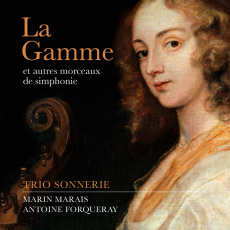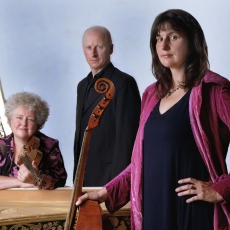Trio Sonnerie - La gamme - Fanfare
La gamme et autres morceaux de simphonie was published by Marais in 1723, six years after his celebrated fourth volume of viol da gamba suites, and two years before his final fifth volume. Its instrumentation was unique in the composer's oeuvre: violin, viol da gamba, and harpsichord, with various combinations possible between and within individual pieces. Three works were included in the publication, of which the Sonnerie de Sainte Geneviève quickly became the most popular of Marais' compositions, with its three-note bell ostinato forming the figuratively varied ground over which the violin pursues a seemingly improvisatory course throughout.
Of the other two works included in that collection, the Sonate à la Marésienne is in seven sections that include imaginatively transfigured dance movements; but it is La Gamme that contains the most extraordinary music on this album. Its forty-five sections traverse a rising and descending tonal arch from C to its octave above and back. It is largely made up of dances and very brief transitions, but with recitative movements as well. Transitions are sudden; and sudden gear shifts in tempo, rhythm, and key mirror a similar treatment in Rebel's ballet, Les caractères de la danse, first performed eight years before La gamme saw light of day. I suspect Marais, who called it en forme de petit Opéra, was playing a typically punning game: both a reference to its mix of dance and recitative as in French Baroque opera, but also by calling this remarkably complex but attractive and lengthy piece a 'small work' in the original Italian meaning of 'opera'.
The disc includes as well a series of pieces by Antoine Forqueray: three arranged for harpsichord and three for viol da gamba with continuo. The selection is judicious; and if 'La Forqueray' and 'La Laborde' were to be expected for their popularity, 'La Cottin' and 'La Portugaise' are nowhere near as often heard.
The Trio Sonnerie has been frequently lauded in these pages, though not recently. If the biographical notes on their website are anything to judge by, they left the trio format and the Baroque era for quite some time. Good news, then, that they've 'now returned, sated, to the trio format' as they put it, and to the Baroque, too, if this disc is anything to judge by. Monica Huggett remains from the original lineup, a violinist I've repeatedly praised in the past. Gambist Emilia Benjamin joined in 1995, and at some unannounced point, harpsichordist James Johnstone replaced Mitzi Meyerson.
The Trio is impeccably stylish. They trade off the lead frequently as required by the music, and always with panache. Their performances are heavily but sensibly accented, rhythmically lively, and varied in tempo and touch. (The jagged assertiveness Benjamin and Johnstone bring to several of Forqueray's pieces and 'La Forqueray' in particular is a nice touch on this self-portrayal of a man widely regarded in his time as arrogant and choleric.) Phrasing is flexible without drawing attention to itself. This holds just as true for Johnstone's solo in the allemande 'La Laborde' by Forqueray as it does the entire Trio's performance of the allemande from the Sonate à la Marésienne, or the various duo combinations that appear throughout La Gamme. All three musicians are clearly on the same interpretative page, something that can't be said of every Baroque ensemble, small or large, that I've heard to date.
This is also a very well-engineered release. All three instruments are simply pleasant to listen to, and they are thoroughly balanced without any obvious tinkering to emphasize one or another performer. I strongly suspect a lot of this has to do with their concertizing. While you can count upon an engineer to redistribute the sound in a rock concert, few of them share their electronic gear with baroque trios, at least, not without being asked nicely.
In short, a highly successful album, both for those who appreciate French baroque viol music, and as a gift for someone completely unfamiliar with it.
Of the other two works included in that collection, the Sonate à la Marésienne is in seven sections that include imaginatively transfigured dance movements; but it is La Gamme that contains the most extraordinary music on this album. Its forty-five sections traverse a rising and descending tonal arch from C to its octave above and back. It is largely made up of dances and very brief transitions, but with recitative movements as well. Transitions are sudden; and sudden gear shifts in tempo, rhythm, and key mirror a similar treatment in Rebel's ballet, Les caractères de la danse, first performed eight years before La gamme saw light of day. I suspect Marais, who called it en forme de petit Opéra, was playing a typically punning game: both a reference to its mix of dance and recitative as in French Baroque opera, but also by calling this remarkably complex but attractive and lengthy piece a 'small work' in the original Italian meaning of 'opera'.
The disc includes as well a series of pieces by Antoine Forqueray: three arranged for harpsichord and three for viol da gamba with continuo. The selection is judicious; and if 'La Forqueray' and 'La Laborde' were to be expected for their popularity, 'La Cottin' and 'La Portugaise' are nowhere near as often heard.
The Trio Sonnerie has been frequently lauded in these pages, though not recently. If the biographical notes on their website are anything to judge by, they left the trio format and the Baroque era for quite some time. Good news, then, that they've 'now returned, sated, to the trio format' as they put it, and to the Baroque, too, if this disc is anything to judge by. Monica Huggett remains from the original lineup, a violinist I've repeatedly praised in the past. Gambist Emilia Benjamin joined in 1995, and at some unannounced point, harpsichordist James Johnstone replaced Mitzi Meyerson.
The Trio is impeccably stylish. They trade off the lead frequently as required by the music, and always with panache. Their performances are heavily but sensibly accented, rhythmically lively, and varied in tempo and touch. (The jagged assertiveness Benjamin and Johnstone bring to several of Forqueray's pieces and 'La Forqueray' in particular is a nice touch on this self-portrayal of a man widely regarded in his time as arrogant and choleric.) Phrasing is flexible without drawing attention to itself. This holds just as true for Johnstone's solo in the allemande 'La Laborde' by Forqueray as it does the entire Trio's performance of the allemande from the Sonate à la Marésienne, or the various duo combinations that appear throughout La Gamme. All three musicians are clearly on the same interpretative page, something that can't be said of every Baroque ensemble, small or large, that I've heard to date.
This is also a very well-engineered release. All three instruments are simply pleasant to listen to, and they are thoroughly balanced without any obvious tinkering to emphasize one or another performer. I strongly suspect a lot of this has to do with their concertizing. While you can count upon an engineer to redistribute the sound in a rock concert, few of them share their electronic gear with baroque trios, at least, not without being asked nicely.
In short, a highly successful album, both for those who appreciate French baroque viol music, and as a gift for someone completely unfamiliar with it.

